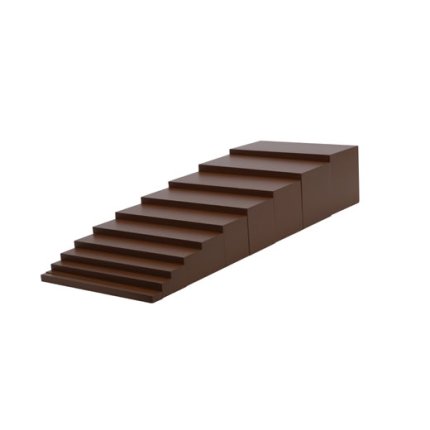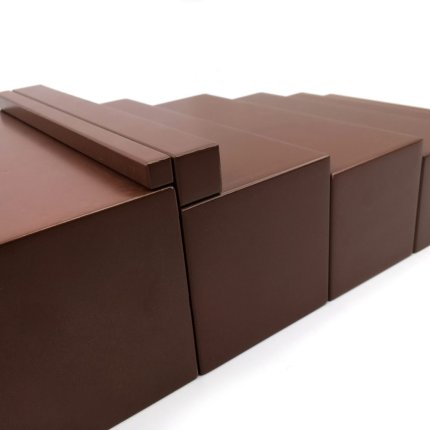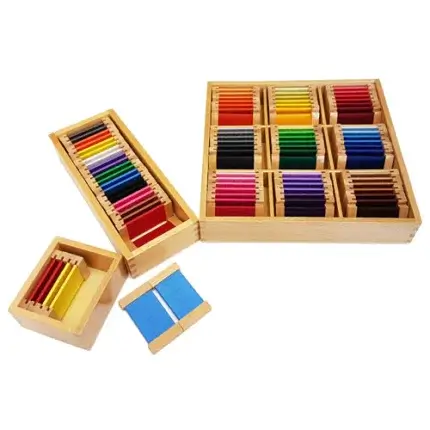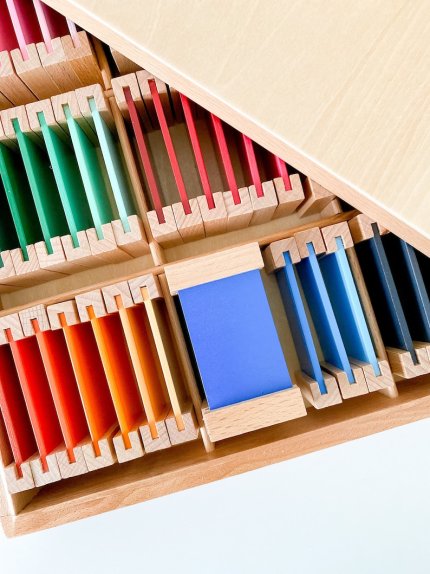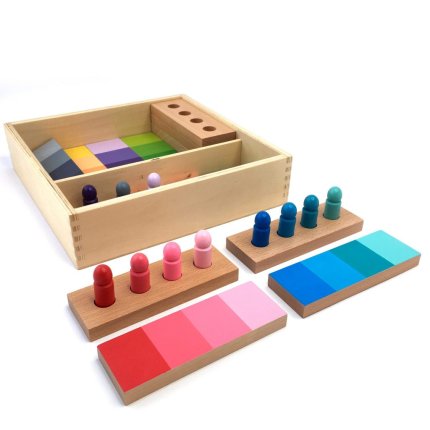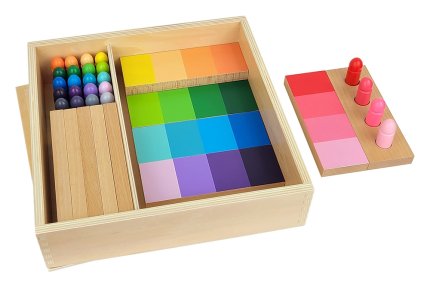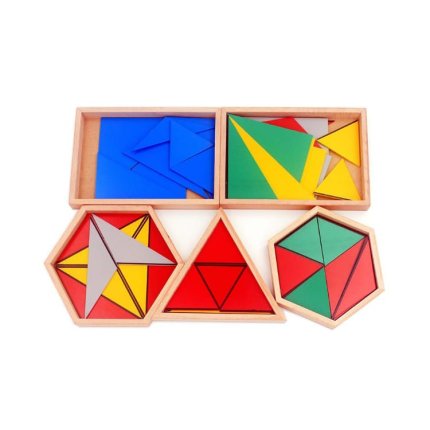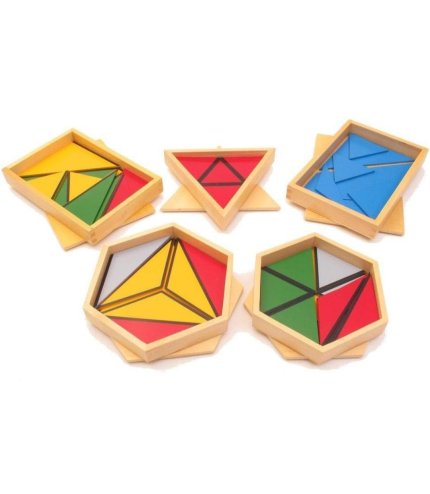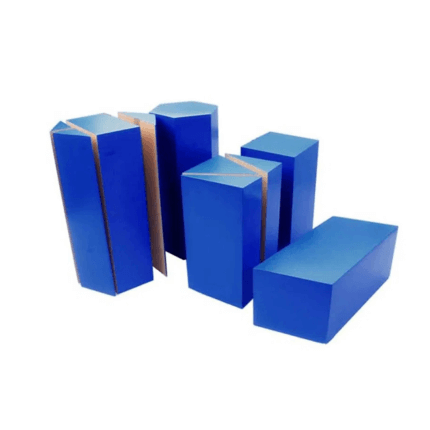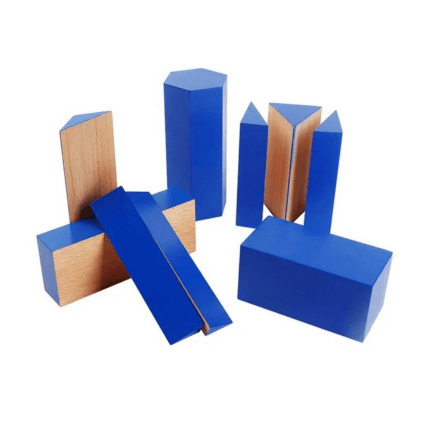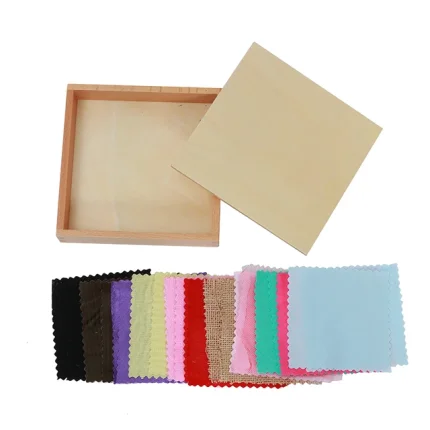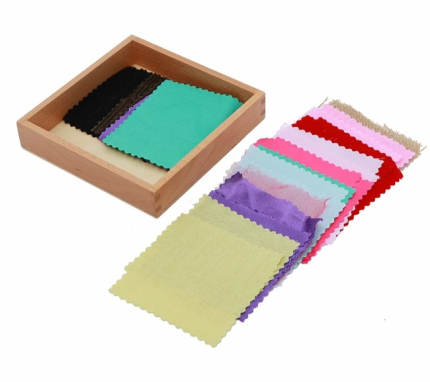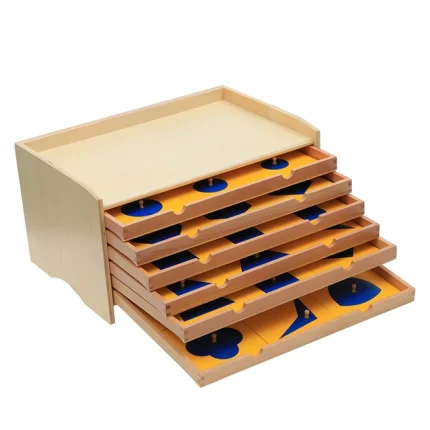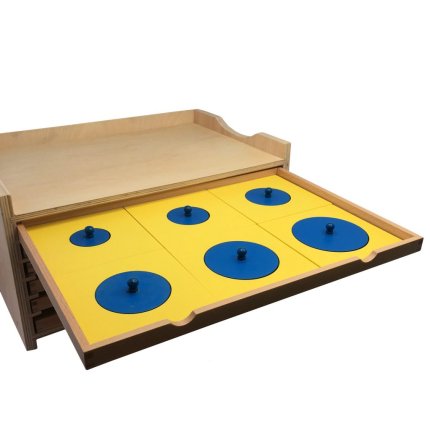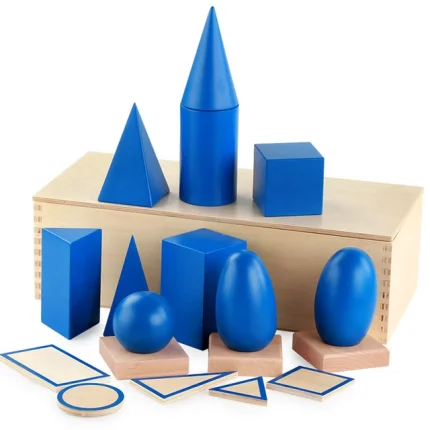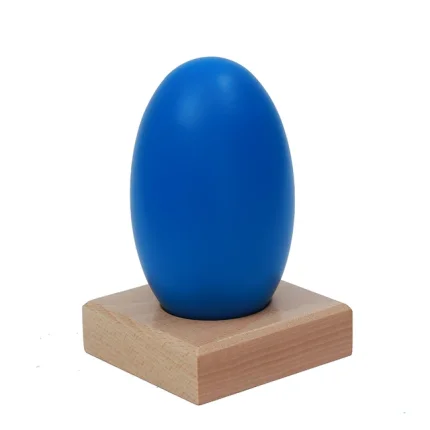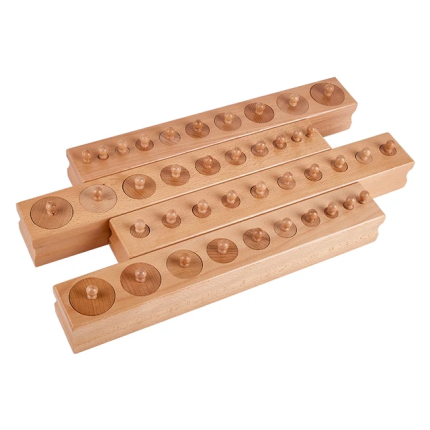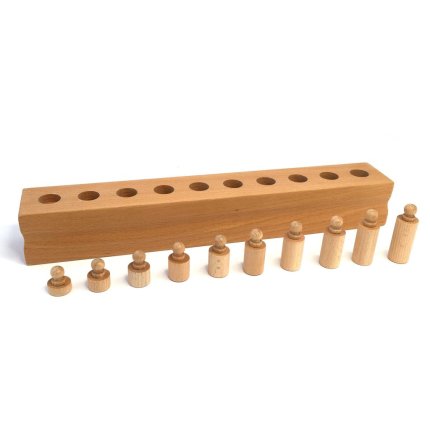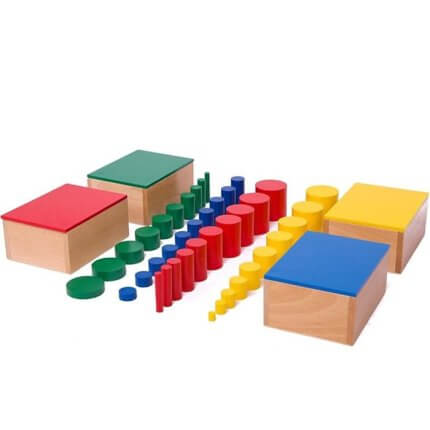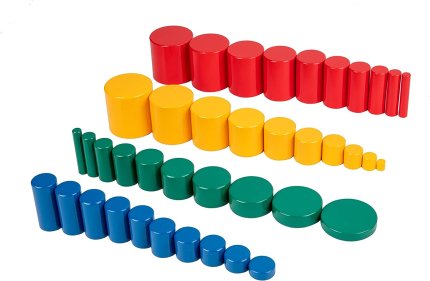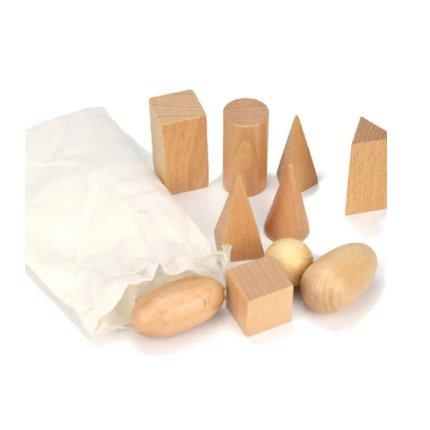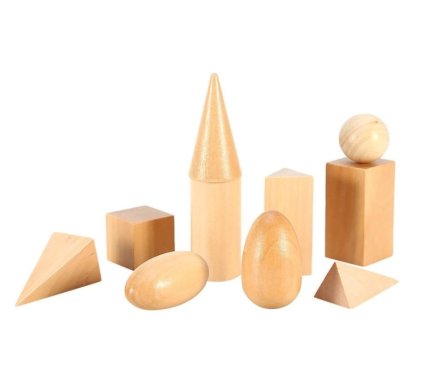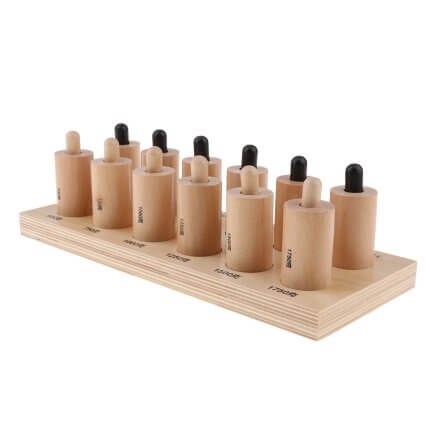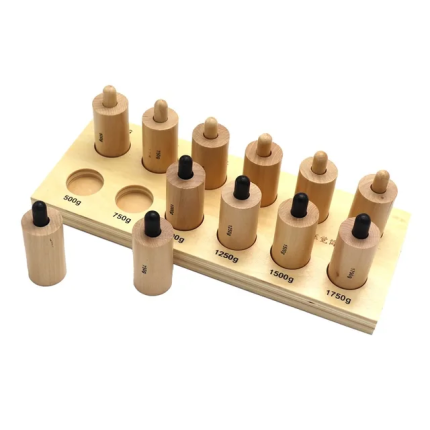Brown stairs
The Montessori Brown Stairs, also known as the Broad Stairs, are a classic sensorial material in the Montessori curriculum. They consist of ten wooden prisms, each with the same length but varying in height and width. This educational tool is designed to help children develop visual and tactile discrimination of size, enhance fine motor skills, and understand mathematical concepts such as sequencing and gradation. The Brown Stairs are typically introduced to children during their primary years, offering a hands-on experience that lays the foundation for more complex learning tasks.
Supplied with a 1 cm spare.
Age 3:6
Color Boxes
Montessori color boxes are a set of educational tools designed to help children develop their sense of color differentiation and gradation. These boxes typically come in three versions, each increasing in complexity. The first box introduces primary colors, the second box includes primary and secondary colors, and the third box offers a range of shades, teaching children to distinguish subtle differences in color. They are widely used in Montessori classrooms to enhance visual perception and are considered a fundamental part of the Montessori sensorial curriculum.
Age 3:6
Color grading
Montessori color grading is a fascinating aspect of the Montessori educational approach, focusing on developing a child's visual discrimination of colors. Through the use of color tablets, children learn to distinguish and match different shades, from the primary colors in the first box to a wide range of hues in subsequent boxes. The activity not only aids in recognizing colors but also in understanding gradients and intensities, as children arrange the tablets in sequences of increasing or decreasing saturation. This sensorial exercise enhances their ability to observe and appreciate the subtle differences within the color spectrum.
Age 3:6
construcrltive triangles
Montessori constructive triangles are a set of specially designed triangular shapes used in Montessori education to help children understand geometric concepts and spatial relationships. These triangles, which come in different sizes and colors, can be combined to form various shapes and patterns, enhancing children's problem-solving skills and creativity. They are typically introduced around the age of 4 and are an integral part of the Montessori sensorial curriculum, preparing children for more advanced geometry work in the future.
Age +4
Departial Geometric
Volume group teaching aids, help children recognize shapes, cultivate children's sense
of entities, and recognize geometric features, Teaching aids are composed of hexagonal
Prism, divided hexagonal prism, rectangular parallelepiped, divided rectangular
Parallelepiped, and quadrangular prism, each crafted to aid in the development of fine motor skills and cognitive abilities. By interacting with these solids, children can grasp complex geometric concepts in a concrete and enjoyable way, laying a foundation for more advanced mathematical learning.
Montessori materials help children cultivate a sense of essence and logic, as well as recognize geometric characteristics.
*About the product
Segmented and complete geometry can be compared, so that children can fully understand the relationship between the part and the whole.
Through the repetition of the three-dimensional geometric group of elements and practical perception, children build different shapes, use hands and mind, exercise their coordination ability.
5pcs. basic figures, two of which are divided into several parts.
*prism: 6cm. x16cm. x6cm.
*rectangle: 6cm. x12cm. x6cm.
*parallelpiped: 6cm. x12cm. x6cm.
Total number of elements: 10pcs.
Age 3:6
Fabrics Box
The Montessori Fabrics Box is a sensorial educational tool designed to refine a child's tactile senses by exploring different textures. Typically, it contains pairs of fabric squares, each offering a unique texture for the child to feel and identify, often with their eyes closed to enhance the tactile experience. This activity not only aids in developing a child's sense of touch but also supports language development as they learn to describe and differentiate between textures such as smooth, rough, soft, or coarse. The Montessori Fabrics Box is a simple yet effective way to engage young learners in sensory exploration and cognitive development.
Age 3:6
Geometric cabinet
The Montessori Geometric Cabinet is a classic educational tool designed to help children develop visual discrimination of shapes. It consists of a wooden cabinet with drawers containing various geometric shapes with knobs, which children can handle and explore. This hands-on approach not only introduces children to basic geometry but also aids in refining motor skills and preparing them for writing. The cabinet is often used in Montessori classrooms to enhance learning through sensory experience and is suitable for children in the primary age range.
Age 3:6
Geometric solids
The purpose of these 3-D shapes is to demonstrate how 3-dimensional shapes are
Related to 2-dimensional shapes. This is great preparation for future geometry and
trigonometry work, They serve as a sensorial material that helps children develop their stereognostic sense and prepare for more advanced geometry work. Through hands-on exploration, children can discover how three-dimensional shapes relate to two-dimensional ones, laying a foundation for understanding spatial relationships and mathematical concepts.
Age: +4
Knobbed cylinders
The Montessori knobbed cylinders are a classic sensorial activity designed to assist children in developing their fine motor skills, visual discrimination, and spatial awareness. These sets typically consist of wooden blocks with variously sized holes to fit the corresponding cylinders, which are equipped with knobs for easy handling. As children engage with these materials, they learn to recognize and differentiate sizes and dimensions, laying a foundational understanding of mathematical concepts. The knobbed cylinders are not only educational but also provide a hands-on experience that encourages concentration and independent learning.
Age 3:6
Knobless cylinders
There are 4 boxes of cylinders are exactly the same dimensions as the knobbed cylinder blocks.
The Montessori Knobless Cylinders are a set of colorful educational tools designed to enhance a child's ability to discern differences in dimension, such as height and diameter. Comprising four sets of ten cylinders, each varying in one or two dimensions, these materials are integral to the Montessori method of teaching. They not only aid in developing a child's visual discrimination skills but also serve as a hands-on approach to learning about spatial relationships, size, and proportion.
Age 3:6
Mysterious bag
The Montessori Mystery Bag is a sensorial activity designed to refine a child's stereognostic sense, which involves identifying objects through touch. It's a simple yet effective tool that encourages children to use their tactile senses to explore and recognize different items without relying on sight. This activity not only enhances sensory perception but also aids in developing concentration, memory, and vocabulary. The Mystery Bag can be filled with a variety of objects, offering endless opportunities for learning and fun.
Age 3:6
Pressure cylinders
the pressure cylinders are a sensorial educational tool designed to help children develop their sense of touch and learn to discriminate between different levels of pressure. These cylinders come in pairs, each with a spring-loaded plunger that provides varying degrees of resistance. Children press down on the plungers to sense the difference in pressure, which aids in pairing and grading activities. This hands-on learning material is typically made of high-quality wood and is used to enhance fine motor skills and concentration in young learners. Montessori materials like these pressure cylinders are widely recognized for their role in promoting active, self-directed learning.
Age 3:6

